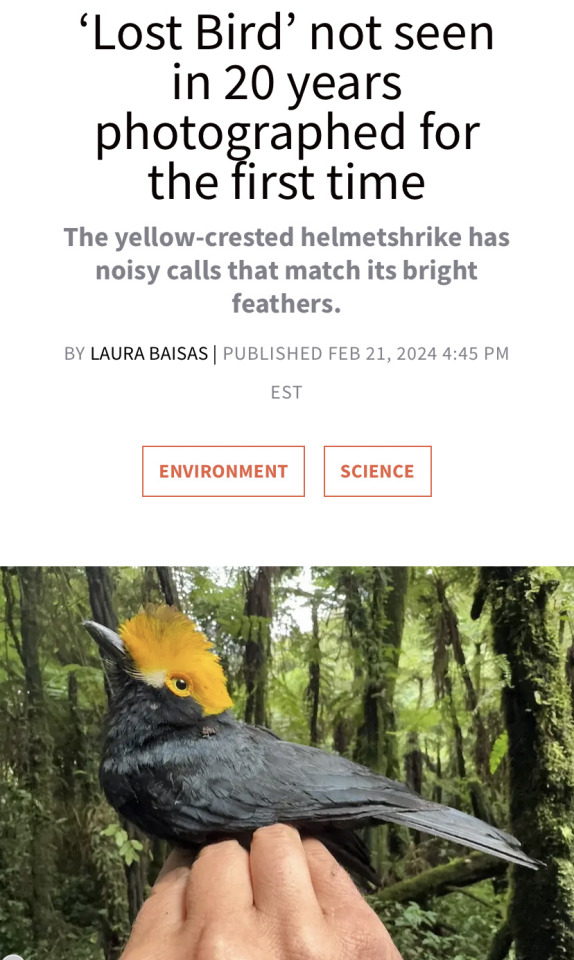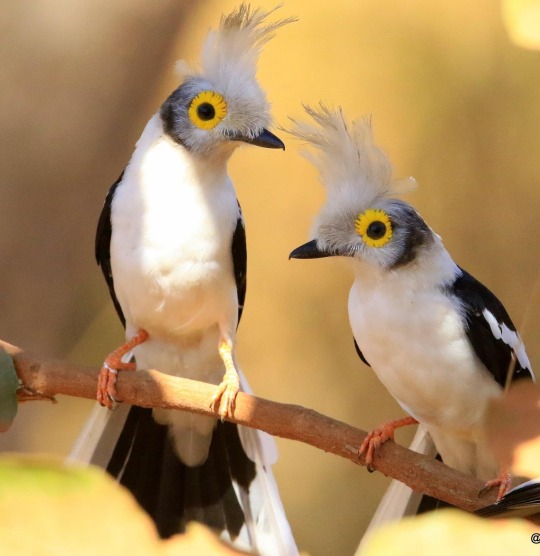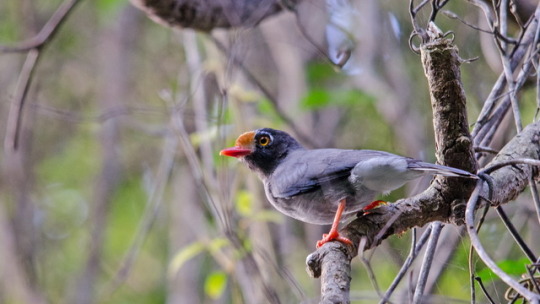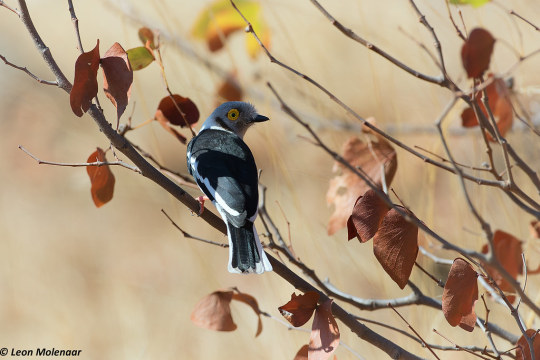#prionops
Explore tagged Tumblr posts
Text

White-crested Helmetshrike (Prionops plumatus), family Vangidae, order Passeriformes, Kenya
photograph by Birdquest
1K notes
·
View notes
Photo

Gabela Helmetshrike (Prionops gabela)
© Shailesh Pinto
295 notes
·
View notes
Photo

Gabela Helmetshrike (Prionops gabela)
© Shailesh Pinto
124 notes
·
View notes
Photo

White-crested Helmetshrike (Prionops plumatus)
© Fikret Ataşalan
37 notes
·
View notes
Text

March 12, 2024 - Red-billed Helmetshrike or Chestnut-bellied Helmetshrike (Prionops caniceps) Found in parts of western Africa, these helmetshrikes live in and around forests, often near water. Foraging in small groups and joining mixed-species flocks, they eat insects, spiders, fruit, and seeds, capturing their prey in flight and picking it from leaves and twigs. Though their breeding habits are not known in detail, they build compact cup-shaped nests in trees, probably breed cooperatively, and may may raise two broods in a season.
#red-billed helmetshrike#helmetshrike#prionops caniceps#bird#birds#illustration#art#water#birblr art
49 notes
·
View notes
Text

Excerpt from this story from Mongabay Environmental News:
Michael Harvey recalls the moment he first saw a flock of yellow-crested helmetshrikes flitting through a cloud forest in the eastern Democratic Republic of Congo: the first confirmed sighting by scientists of the species in 16 years.
“It was more bizarre and exciting than I could have imagined,” says Harvey, an ornithologist and assistant professor at the University of Texas at El Paso (UTEP).
In December 2023, he and a team of U.S. and DRC ornithologists and herpetologists trekked for weeks in cars, on motorbikes and on foot to reach the Itombwe massif, on the western edge of the Albertine Rift, a vast ecoregion of mountains, valleys and forests spanning five countries in East Africa.
Harvey and a DRC assistant had left their camp to hike up a ridge to look for cloud forest birds. When they reached a fern meadow in a natural forest clearing, rain clouds swept in, and thick swirling mist reduced visibility to around 10 meters (33 feet).
“I’m in the meadow, and inside the cloud forest, I start hearing these wild, snapping sounds and squeals that sounded like wind-up toys,” Harvey says. “Then, out of this pea-soup fog, I see these jet-black shapes, almost blacker than black, starting to emerge in the fog, and I raise my binoculars and that’s when I can see these brilliant, bright, whitish-yellow crests on the birds, the yellow eyes, the yellow eye wattles, and the pink-red legs.”
It was a small flock of six to eight yellow-crested helmetshrikes (Prionops alberti), a species he’d only previously known from books — and one that scientists hadn’t sighted since 2007.
“They were interacting with each other, making these bizarre sounds and doing acrobatics right on the edge of this clearing and then they sort of melted back into the forest and moved down the ridge.”
Finding the yellow-crested helmetshrike wasn’t the main reason Harvey went to Itombwe, though it was a “dream bird” that had been at the back of his mind alongside the Itombwe owl (Tyto prigoginei) and Itombwe nightjar (Caprimulgus prigoginei). The latter two haven’t been recorded by scientists since 1996 and 1955, respectively.
The main reason Harvey went to Itombwe was to obtain a genetic sample from the Grauer’s broadbill (Pseudocalyptomena graueri), a tiny, brilliant-green bird that’s the sole species in its genus. He succeeded: both observing a pair of Grauer’s broadbills and taking a genetic sample. But his first encounter with the helmetshrikes, and further ones the team had during the six-week-long expedition, stick vividly in his mind.
10 notes
·
View notes
Text
Keltaharjalepinkäinen (Prionops alberti)

WELCOME BACK YELLOW-CRESTED HELMETSHRIKE!!!
30K notes
·
View notes
Note
For the inktober requests: White-crested helmetshrike! (Prionops plumatus cristatus specifically)
thank you for your idea :-)
#i'm not 100% satisfied with this piece though :'D#the white crested helmetshrike is a fantastic bird and i'm not sure i did it justice. Something about my inking makes it feel a little off#there's only so much you can do in a day. my next one will only be better :D#request#ask
1 note
·
View note
Text
First Known Photos of ‘Lost Bird’ Captured by University of Texas Scientists
New Post has been published on https://petn.ws/nT0Js
First Known Photos of ‘Lost Bird’ Captured by University of Texas Scientists
The first-ever photograph of Yellow-crested Helmetshrike (Prionops alberti) Credit: Matt Brady / The University of Texas at El Paso For the first time, scientists have captured photos of a bird in Africa that was unseen for nearly twenty years. Known as the Yellow-crested Helmetshrike, the species had been listed as a ‘lost bird’ by the […]
See full article at https://petn.ws/nT0Js #BirdNews
0 notes
Text
Une expédition de scientifiques a retrouvé un « oiseau perdu » il y a des décennies
La pie-grièche casquée à huppe jaune (Prionops alberti) n’avait pas été observée depuis près de deux décennies. D’où son classement par l’American Bird Conservancy comme « oiseau perdu »
0 notes
Text
0 notes
Text

White-crested Helmetshrike (Prionops plumatus), family Vangidae, found throughout much of Africa
Photograph by ASalfa Deri
2K notes
·
View notes
Text
0 notes
Photo

Prionops caniceps by anna pang
#bird#birds#animal#animals#biology#nature#wildlife#fauna#Passeriformes#Vangidae#Prionops#Prionops caniceps
59 notes
·
View notes
Photo

White-crested Helmetshrike (Prionops plumatus)
© Leon Molenaar
14 notes
·
View notes
Text

August 23, 2023 - Retz's Helmetshrike (Prionops retzii) These helmetshrikes are found in woodlands, often near rivers, forests, thickets, scrub, and mangroves across parts of southern and eastern Africa. They feed on insects, such as beetles, butterflies, and termites, as well as spiders and small reptiles, foraging in flocks. Breeding pairs are usually assisted by other males and females, likely the pair’s siblings. The groups build shallow cup-shaped nests from lichen, leaf stems, grass, and thin bark, held together with spiderwebs. All group members incubate the eggs and care for the chicks.
50 notes
·
View notes